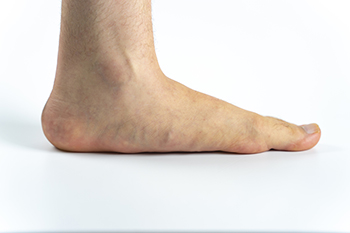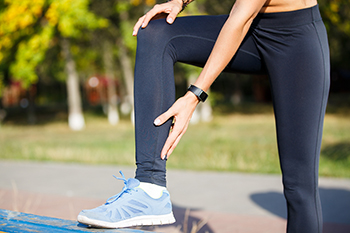Langley (604)-530-1561
Fax (778)-278-1561
Email podiatry@urton.ca
April 2022
Do I Have Flat Feet?

The medical term for fallen arches or flat feet is known as pes planus. It is noticeable when the foot lies flat on the floor, and the arch is absent. Some patients do not have symptoms, or may experience mild pain or achiness in different parts of the leg. Most people are born with flat feet, and the arch generally forms in the teenage years. This condition may develop from genetic reasons, obesity, or possibly from a foot injury. Additionally, a dysfunction of one or more of the muscles in the foot may lead to flat feet. It is beneficial for patients who have flat feet to wear shoes that are supportive, and this may help to prevent future injuries. People who have flat feet are advised to consult with a podiatrist who can offer custom-made orthotics for relief.
Flatfoot is a condition many people suffer from. If you have flat feet, contact William Urton, DPM from British Columbia. Our doctor will treat your foot and ankle needs.
What Are Flat Feet?
Flatfoot is a condition in which the arch of the foot is depressed and the sole of the foot is almost completely in contact with the ground. About 20-30% of the population generally has flat feet because their arches never formed during growth.
Conditions & Problems:
Having flat feet makes it difficult to run or walk because of the stress placed on the ankles.
Alignment – The general alignment of your legs can be disrupted, because the ankles move inward which can cause major discomfort.
Knees – If you have complications with your knees, flat feet can be a contributor to arthritis in that area.
Symptoms
- Pain around the heel or arch area
- Trouble standing on the tip toe
- Swelling around the inside of the ankle
- Flat look to one or both feet
- Having your shoes feel uneven when worn
Treatment
If you are experiencing pain and stress on the foot you may weaken the posterior tibial tendon, which runs around the inside of the ankle.
If you have any questions please feel free to contact our office located in Langley, BC . We offer the newest diagnostic and treatment technologies for all your foot and ankle needs.
All About Your Feet
It’s easy to depend on our feet to stand, walk, run, exercise, play sports, and dance. But even though our feet are such an important part of our lives, they are, quite frankly, often either taken for granted or ignored. The foot is a complex collection of 26 bones, 33 joints, more than 100 ligaments, and a number of muscles. These work to get us where we want to go and do what we want them to do, most of the time without any real conscious thought. As you age, or if you are extremely active, however, caring for your feet becomes more important. Parts wear out, bones get thinner, padding starts to disappear, and injury can follow. Some simple basics can keep your feet healthy: keeping your feet clean, dry and moisturized daily is a good idea. Checking for calluses and corns and having them removed is recommended. Keeping toenails in good trim and straight across, helps prevent ingrown toenails. Proper footwear that offers room for your toes, support for your arches, padding for your heels, and avoiding high heels are other ways to protect your feet. It is suggested that you make regular appointments for a checkup with a podiatrist, especially if you have any foot pain or deformities, to promote good foot health.
Everyday foot care is very important to prevent infection and other foot ailments. If you need your feet checked, contact William Urton, DPM from British Columbia. Our doctor can provide the care you need to keep you pain-free and on your feet.
Everyday Foot Care
Often, people take care of their bodies, face and hair more so than they do for their feet. But the feet are a very important aspect of our bodies, and one that we should pay more attention to. Without our feet, we would not be able to perform most daily tasks.
It is best to check your feet regularly to make sure there are no new bruises or cuts that you may not have noticed before. For dry feet, moisturizer can easily be a remedy and can be applied as often as necessary to the affected areas. Wearing shoes that fit well can also help you maintain good foot health, as well as making it easier to walk and do daily activities without the stress or pain of ill-fitting shoes, high heels, or even flip flops. Wearing clean socks with closed shoes is important to ensure that sweat and bacteria do not accumulate within the shoe. Clean socks help to prevent Athlete’s foot, fungi problems, bad odors, and can absorb sweat.
If you have any questions please feel free to contact our office located in Langley, BC . We offer the newest diagnostic and treatment technologies for all your foot and ankle needs.
What Causes Achilles Tendinitis
The Achilles tendon connects the two large calf muscles at the back of the leg to the heel bone. It makes flexing the foot possible, along with walking, running, and jumping. When the Achilles tendon becomes damaged, swollen, and painful, it is known as Achilles tendinitis or Achilles tendinopathy. This condition can occur for a variety of reasons including failing to warm up the calf muscles prior to working out, wearing shoes that do not support the feet properly, suddenly increasing the intensity/amount of physical activity, running too often or on hard surfaces, participating in activities with a lot of jumping, or accidentally turning your foot in or out abruptly. Other risk factors for Achilles tendinitis include being a middle-aged or older adult or having flat feet or a growth or heel spur at the back of the heel (both of which can irritate or put pressure on the tendon). If you believe you have Achilles tendinitis, make an appointment with your podiatrist as soon as possible to begin treatment.
Achilles tendon injuries need immediate attention to avoid future complications. If you have any concerns, contact William Urton, DPM of British Columbia. Our doctor can provide the care you need to keep you pain-free and on your feet.
What Is the Achilles Tendon?
The Achilles tendon is a tendon that connects the lower leg muscles and calf to the heel of the foot. It is the strongest tendon in the human body and is essential for making movement possible. Because this tendon is such an integral part of the body, any injuries to it can create immense difficulties and should immediately be presented to a doctor.
What Are the Symptoms of an Achilles Tendon Injury?
There are various types of injuries that can affect the Achilles tendon. The two most common injuries are Achilles tendinitis and ruptures of the tendon.
Achilles Tendinitis Symptoms
- Inflammation
- Dull to severe pain
- Increased blood flow to the tendon
- Thickening of the tendon
Rupture Symptoms
- Extreme pain and swelling in the foot
- Total immobility
Treatment and Prevention
Achilles tendon injuries are diagnosed by a thorough physical evaluation, which can include an MRI. Treatment involves rest, physical therapy, and in some cases, surgery. However, various preventative measures can be taken to avoid these injuries, such as:
- Thorough stretching of the tendon before and after exercise
- Strengthening exercises like calf raises, squats, leg curls, leg extensions, leg raises, lunges, and leg presses
If you have any questions please feel free to contact our office located in Langley, BC . We offer the newest diagnostic tools and technology to treat your foot and ankle needs.
It's Time for Beautiful Feet
Blisters Will Gradually Drain
 A small area on the skin that is filled with liquid and resembles a bubble is referred to as a blister. Its function is to protect the damaged skin while new skin grows, and will gradually drain when the body no longer needs it. A blister often develops as a result of excessive friction from wearing shoes that do not fit correctly. Additionally, blisters can form from certain medical conditions, including psoriasis, frostbite, and eczema. An allergic reaction to an insect bite may cause a blister, or one may develop from specific types of chemicals. The blister can be protected by placing a bandage over it, as daily activities are completed. If you frequently develop blisters on your feet, please consult with a podiatrist who can provide you with reasons why and suggest correct preventative techniques.
A small area on the skin that is filled with liquid and resembles a bubble is referred to as a blister. Its function is to protect the damaged skin while new skin grows, and will gradually drain when the body no longer needs it. A blister often develops as a result of excessive friction from wearing shoes that do not fit correctly. Additionally, blisters can form from certain medical conditions, including psoriasis, frostbite, and eczema. An allergic reaction to an insect bite may cause a blister, or one may develop from specific types of chemicals. The blister can be protected by placing a bandage over it, as daily activities are completed. If you frequently develop blisters on your feet, please consult with a podiatrist who can provide you with reasons why and suggest correct preventative techniques.
Blisters are prone to making everyday activities extremely uncomfortable. If your feet are hurting, contact William Urton, DPM of British Columbia. Our doctor can provide the care you need to keep you pain-free and on your feet.
Foot Blisters
Foot blisters develop as a result of constantly wearing tight or ill-fitting footwear. This happens due to the constant rubbing from the shoe, which can often lead to pain.
What Are Foot Blisters?
A foot blister is a small fluid-filled pocket that forms on the upper-most layer of the skin. Blisters are filled with clear fluid and can lead to blood drainage or pus if the area becomes infected.
How Do Blisters Form?
Blisters on the feet are often the result of constant friction of skin and material, usually by shoe rubbing. Walking in sandals, boots, or shoes that don’t fit properly for long periods of time can result in a blister. Having consistent foot moisture and humidity can easily lead to blister formation.
Prevention & Treatment
It is important to properly care for the affected area in order to prevent infection and ease the pain. Do not lance the blister and use a Band-Aid to provide pain relief. Also, be sure to keep your feet dry and wear proper fitting shoes. If you see blood or pus in a blister, seek assistance from a podiatrist.
If you have any questions, please feel free to contact our office located in Langley, BC . We offer the newest diagnostic and treatment technologies for all your foot care needs.










